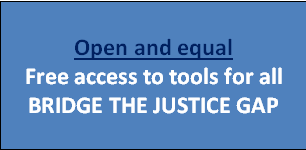On November 30, 2023, the American Bar Association released its fifth annual Profile of the Legal Profession. This free report, a 140-page compilation of statistics and trends about lawyers, judges, and law students, includes sections on demographics, wages, law schools, judges, pro bono work, women in the profession, legal technology, lawyer well-being, and lawyer discipline. One additional chapter — a review of civil legal aid in the United States — is the feature we wish to explore in today’s blog post.
Read moreLegal Tech and the Justice Gap -- A Few Haiku for Poetry Month
Today is the last day of National Poetry Month. We’ve been celebrating all month long with an exhibit called Poetry of the Bench and Bar. Today, we conclude the celebration with a few haiku — variations on a theme of bridging the justice gap. Enjoy!
Geography and the Law Exhibit at the Harris County Law Library
This month, the Law Library is exploring Geography and The Law, a new exhibit on display until February 28th. Learn how a treasure map and a Google Earth satellite image played a role in two recent court decisions and how a Story Map is impacting access to justice.
The following cases are featured in the exhibit.
United States of America v. Paciano Lizarraga-Tirado, 789 F. 3d 1107 (2015)
After a Border Patrol agent recorded the GPS coordinates of a defendant’s arrest using a handheld device, the evidence was questioned as hearsay. The panel of judges in this case disagreed. Google Earth satellite images, like photographs, make no assertion, even when the software identifies a specific location on that image with a tack and GPS coordinates. Tack-coordinate pairs are auto-generated and require no human intervention. As such, images labeled in this way are not hearsay.
Smith v. The Abandoned Vessel, 610 F. Supp. 3d 868 (2009)
Plaintiff Nathan Smith, a self-described treasure hunter, sought title, under the law of finds, to a legendary sunken ship in Refugio County, Texas. To locate the ship, Smith consulted an 1851 county map along with GPS data and satellite images from Google Earth. He cobbled together his own sort of treasure map and felt certain that he had found the long-lost vessel. Unfortunately, his spurious claims and questionable geographic and scientific evidence failed to persuade the court. The case was dismissed.
Texas Supreme Court Commission to Expand Legal Services Releases Justice Gap Report
On December 6, 2016, the Commission to Expand Civil Legal Services released eight recommendations for increasing the public's access to justice in Texas. As part of these recommendations, the Commission presented innovative options for those of modest means to participate in the legal system and thereby narrow the justice gap in Texas. Two overarching goals guided the Commission in the drafting of its report: connecting lower and middle-income clients with affordable representation and helping pro se litigants navigate the court system.
According to the report, the success of current initiatives has been dependent upon the participation of public law libraries at the state and county levels. Recognizing the essential role that libraries play, the Commission's report encourages the court to promote adequate funding for public law libraries and for the placement of navigators in libraries, courthouses, and other public spaces.
In addition to the Travis County Law Library and the Texas State Law Library, the Harris County Law Library was recognized by the Commission for taking steps to close the justice gap. We at the Harris County Law Library are very proud of this recognition, as well as our partnership with the Houston Volunteer Lawyers Program in providing services to the populations targeted by the Commission’s recommendations and objectives. We look forward to continuing to provide assistance to our library clientele, helping them to navigate their way through the justice system.









